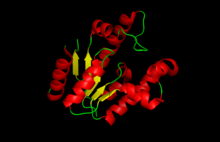User:NBonawitz/sandboxShikimateKinase
| shikimate kinase | |||||||||
|---|---|---|---|---|---|---|---|---|---|
| Identifiers | |||||||||
| EC no. | 2.7.1.71 | ||||||||
| CAS no. | 9031-51-0 | ||||||||
| Databases | |||||||||
| IntEnz | IntEnz view | ||||||||
| BRENDA | BRENDA entry | ||||||||
| ExPASy | NiceZyme view | ||||||||
| KEGG | KEGG entry | ||||||||
| MetaCyc | metabolic pathway | ||||||||
| PRIAM | profile | ||||||||
| PDB structures | RCSB PDB PDBe PDBsum | ||||||||
| Gene Ontology | AmiGO / QuickGO | ||||||||
| |||||||||
| Shikimate kinase | |||||||||||
|---|---|---|---|---|---|---|---|---|---|---|---|
 Shikimate kinase of Erwinia chrysanthemi | |||||||||||
| Identifiers | |||||||||||
| Symbol | SKI | ||||||||||
| Pfam | PF01202 | ||||||||||
| Pfam clan | CL0023 | ||||||||||
| InterPro | IPR000623 | ||||||||||
| PROSITE | PDOC00868 | ||||||||||
| SCOP2 | 2shk / SCOPe / SUPFAM | ||||||||||
| OPM protein | 1e6c | ||||||||||
| |||||||||||
Shikimate kinase (EC 2.7.1.71) is an enzyme that catalyzes the ATP-dependent phosphorylation of shikimate to form shikimate 3-phosphate. This reaction is the fifth step of the shikimate pathway[1], which is used by plants and bacteria to synthesize the common precursor of aromatic amino acids and secondary metabolites. The systematic name of this enzyme class is ATP:shikimate 3-phosphotransferase. Other names in common use include shikimate kinase (phosphorylating), and shikimate kinase II.
Background[edit]
The shikimate pathway consists of seven enzymatic reactions by which phosphoenolpyruvate and erythrose 4-phosphate are converted to chorismate, the common precursor of the aromatic amino acids phenylalanine, tyrosine, and tryptophan. The aromatic amino acids are used in the synthesis of proteins and, in plants, fungi, and bacteria, give rise to a number of other specialized metabolites, such as phenylpropanoids and alkaloids. Chorismate and several other intermediates of the pathway serve as precursors for a number of other metabolites, such as folates, quinates, and quinones. The four enzymes that precede shikimate kinase in the pathway are DAHP synthase, 3-dehydroquinate synthase, 3-dehydroquinate dehydratase, and shikimate dehydrogenase, and the two that follow it are EPSP synthase and chorismate synthase. The shikimate pathway is not found in humans and other animals, which must obtain the aromatic amino acids from their food.
Activity[edit]
The reaction catalyzed by shikimate kinase is shown below:

This reaction involves the transfer of a phosphate group from ATP to the 3-hydroxyl group of shikimate. Shikimate kinase thus has two substrates, shikimate and ATP, and two products, shikimate 3-phosphate and ADP.
Structure[edit]


As of late 2007, 26 structures have been solved for this class of enzymes, with PDB accession codes 1E6C, 1KAG, 1L4U, 1L4Y, 1SHK, 1U8A, 1VIA, 1WE2, 1ZUH, 1ZUI, 1ZYU, 2DFN, 2DFT, 2G1J, 2G1K, 2IYQ, 2IYR, 2IYS, 2IYT, 2IYU, 2IYV, 2IYW, 2IYX, 2IYY, 2IYZ, and 2SHK.
References[edit]
- ^ Herrmann, K. M.; Weaver, L. M. (1999). "The Shikimate Pathway". Annual Review of Plant Physiology and Plant Molecular Biology. 50: 473–503. doi:10.1146/annurev.arplant.50.1.473. PMID 15012217.
